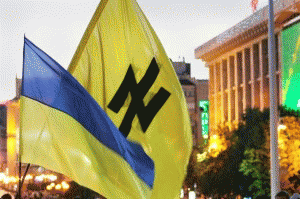Reprinted from Consortium News
The parliament, aware of the obvious public relations fiasco that would follow if it bowed to far-right demands to honor members of the Nazi-affiliated Ukrainian Insurgent Army (or UIA), defeated the proposal. That touched off riots by an estimated 8,000 protesters led by Ukraine's right-wing Svoboda party and the Right Sektor.
Historians blame the UIA and other Ukrainian fascist forces for the extermination of thousands of Poles and Jews during World War II as these right-wing Ukrainian paramilitaries sided with the German Nazis in their fight against the Soviet Union's Red Army. Svoboda and the Right Sektor have elevated UIA leader Stepan Bandera to the level of a Ukrainian national hero.
But Svoboda and Right Sektor activists are not just neo-Nazi street protesters. They were key figures in last February's violent uprising that overthrew elected President Viktor Yanukovych and established a coup regime that the U.S. State Department quickly recognized as "legitimate." Many far-right militants have since been incorporated into the Ukrainian military in its fight to crush resistance to the coup regime from ethnic Russians in Ukraine's east.
Though played down by the Western press, the neo-Nazi affiliations of these militants have occasionally popped up in news stories, including references to displays of Nazi insignias, but usually these citations are mentioned only in passing or are confined to the last few paragraphs of lengthy stories or are dismissed as "Russian propaganda."
But this neo-Nazi reality continues to be an inconvenient truth about the U.S.-backed coup regime that seized power in Kiev with the overthrow of Yanukovych on Feb. 22. Several government ministries, including national security, were given to these far-right elements in recognition of their key role in the putsch that forced members of Yanukovych's government to flee for their lives.
The larger historical context is that Nazism has been deeply rooted in western Ukraine since World War II, especially in cities like Lviv, where a cemetery to the veterans of the Galician SS, a Ukrainian affiliate of the Nazi SS, is maintained. These old passions were brought to the surface again in the battle to oust Yanukovych and sever historic ties to Russia.
The muscle behind the U.S.-backed Maidan protests against Yanukovych came from neo-Nazi militias trained in western Ukraine, organized into 100-man brigades and dispatched to Kiev. After the coup, neo-Nazi leader Andriy Parubiy, who was commander of the Maidan "self-defense forces," was elevated to national security chief and soon announced that the Maidan militia forces would be incorporated into the National Guard and sent to eastern Ukraine to fight ethnic Russians resisting the coup regime.
At War in the East
As the U.S. government and media cheered this "anti-terrorist operation," the neo-Nazis and other right-wing battalions engaged in brutal street fighting against Russian ethnic rebels. Only occasionally did this nasty reality slip into the major U.S. news media. For instance, an Aug. 10 article in the New York Times mentioned the neo-Nazi paramilitaries at the end of a lengthy story on another topic.
"The fighting for Donetsk has taken on a lethal pattern: The regular army bombards separatist positions from afar, followed by chaotic, violent assaults by some of the half-dozen or so paramilitary groups surrounding Donetsk who are willing to plunge into urban combat," the Times reported.
"Officials in Kiev say the militias and the army coordinate their actions, but the militias, which count about 7,000 fighters, are angry and, at times, uncontrollable. One known as Azov, which took over the village of Marinka, flies a neo-Nazi symbol resembling a Swastika as its flag." [See Consortiumnews.com's "NYT Discovers Ukraine's Neo-Nazis at War."]
The conservative London Telegraph offered more details about the Azov battalion in an article by correspondent Tom Parfitt, who wrote:
"Kiev's use of volunteer paramilitaries to stamp out the Russian-backed Donetsk and Luhansk 'people's republics'... should send a shiver down Europe's spine."Recently formed battalions such as Donbas, Dnipro and Azov, with several thousand men under their command, are officially under the control of the interior ministry but their financing is murky, their training inadequate and their ideology often alarming. The Azov men use the neo-Nazi Wolfsangel (Wolf's Hook) symbol on their banner and members of the battalion are openly white supremacists, or anti-Semites."
Based on interviews with militia members, the Telegraph reported that some of the fighters doubted the reality of the Holocaust, expressed admiration for Adolf Hitler and acknowledged that they are indeed Nazis.
(Note: You can view every article as one long page if you sign up as an Advocate Member, or higher).






